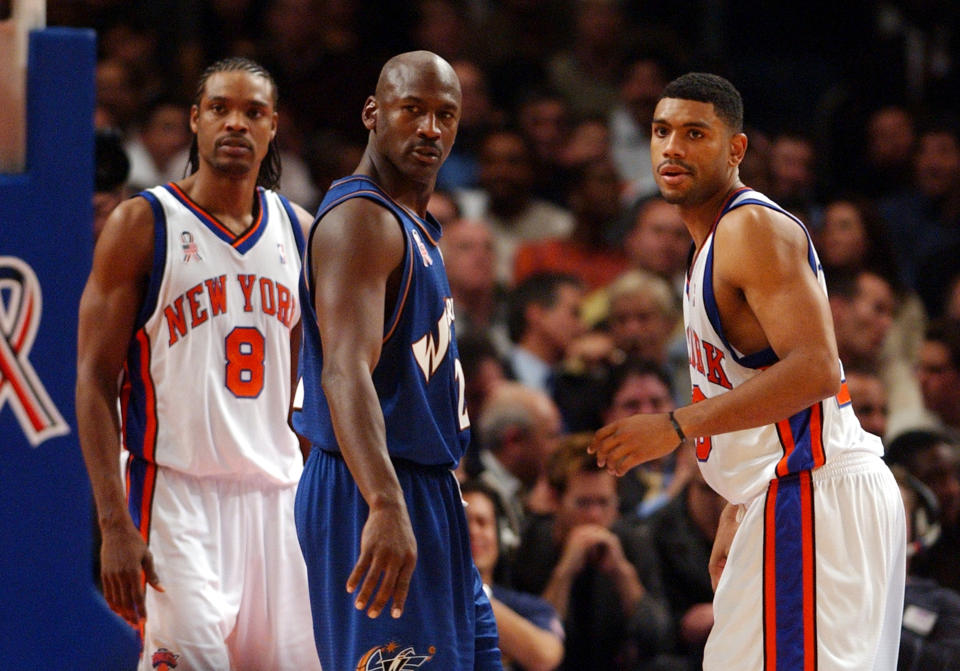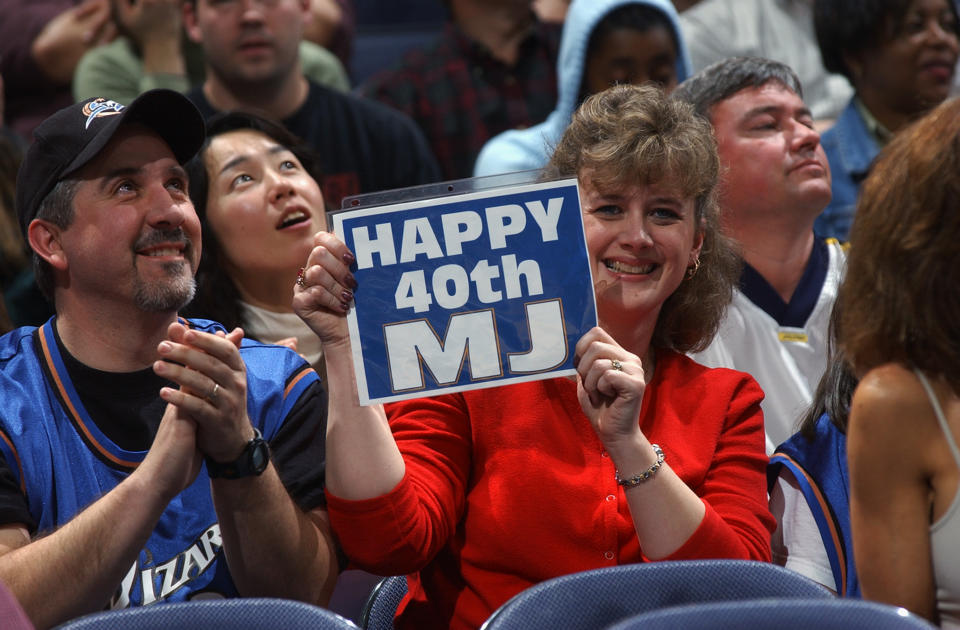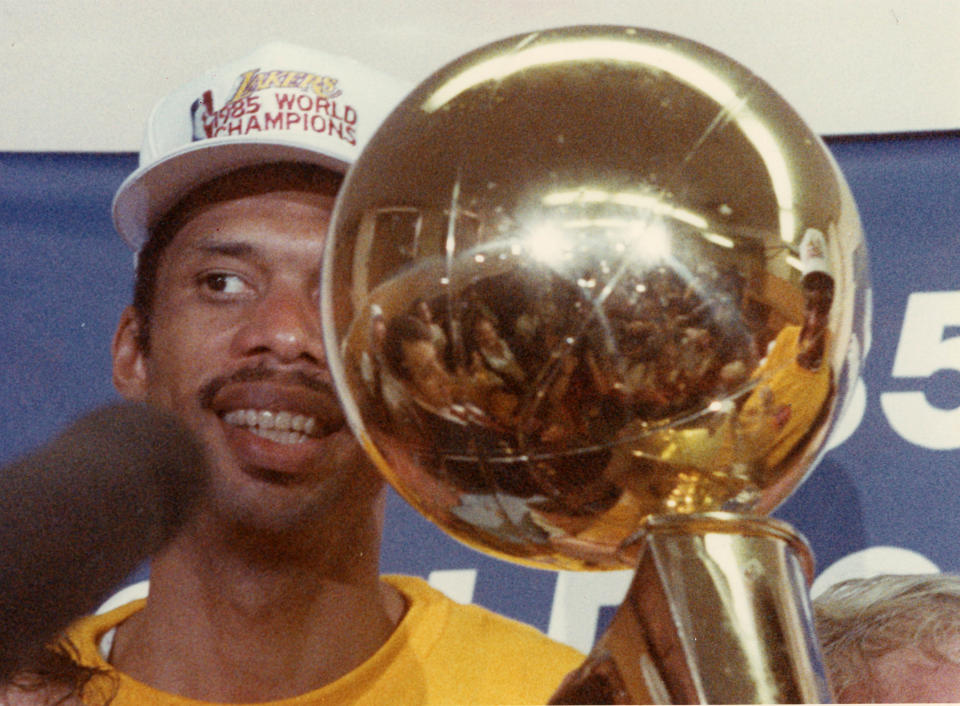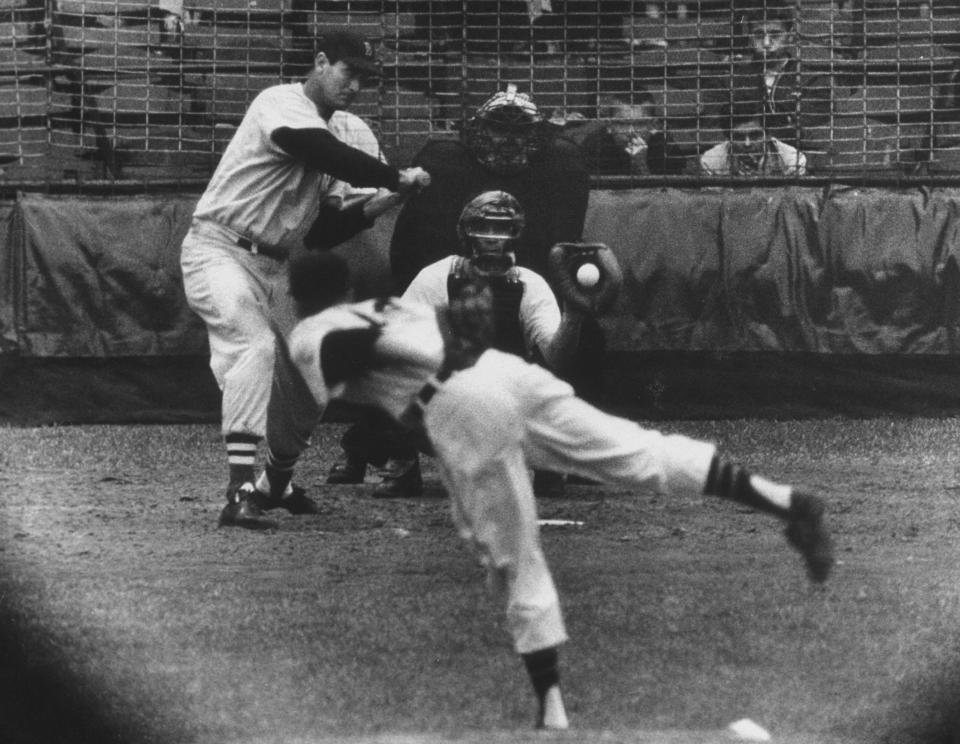After 'The Last Dance': Michael Jordan's final season and other great 'old-athlete' performances
When Michael Jordan crossed up Bryon Russell and drained the jumper that sealed the 1998 title, the G.O.A.T. was 35 years old.
He was the same age then that LeBron James is now — the same age as Jerry West, Oscar Robertson, Bill Russell and Larry Bird in their final seasons. It's not an uncommon walk-away age for NBA superstars. Wilt Chamberlain and Magic Johnson retired at 36, Julius Erving and Kobe Bryant at 37. That's the usual end of the career range, at least in pro hoops.
LeBron, of course, is not showing any glaring signs of decline. He currently leads the NBA's suspended season in assists (10.6 per game), plus he's scoring 25.7 points per game for a team with the best record in its conference. In broad brushstrokes, it's a year similar to Jordan's last in Chicago. We can only guess at what the final years of James' career will look like (or when they'll arrive), but he's clearly tracking to be one of the most dominant older athletes we've seen in any sport.
On Sunday, ESPN debuted the first episodes of "The Last Dance" — a lengthy docu-series on the sixth and final championship season of Jordan's tenure with the Bulls. That iteration of the team was something less than the 72-win machine that had humbled the rest of the NBA two years prior, but it was still, like MJ himself, relentless and brilliant enough to seem invincible. And so the Bulls won. If Jordan would have ended his playing days following the Utah series, it would have been almost obnoxiously perfect — too tidy an ending, too fairytale.

But obviously Jordan was terrible at retiring. He walked away from the Bulls in '98, then walked right back to basketball in Washington at age 38. And for an old dude, he was actually historically productive. There's a kind of heroism in any great player's decision to continue way past his or her peak, wringing whatever value he or she can from whatever's left. Fans don't necessarily want to see it, but a full career arc includes the downslope.
Our purpose here is to recall the greatest individual seasons produced by legends who played well beyond their use-by dates, much like post-Chicago MJ — players who could have reasonably retired years before they delivered historic performances. We're not limiting this to the NBA, but instead taking a wider sweep of the major North American team sports. Consider this an unranked rundown of the greatest olds of all time.
LeBron seems certain to eventually join this group. Jordan is already part of it.
Michael Jordan, Washington Wizards, 2002-03 (age 39-40)
Perhaps you think of MJ's final seasons as something of a punchline at the end of an otherwise impeccable career. His teammates on the Wizards definitely weren't thrilled at all times to play with an aging icon. But let's not completely dismiss Jordan's exit year.
Consider this blind comparison of two full-season stat lines:
Player A - 23.6 PPG, 7.1 RPG, 2.9 AST, 1.4 STL, 0.9 BLK, 44.8 FG%, 80.6 FT%, 3.0 VORP
Player B - 20.0 PPG, 6.1 RPG, 3.8 AST, 1.5 STL, 0.5 BLK, 44.5 FG%, 82.1 FT%, 2.8 VORP
Pretty much everyone should agree that Player A is a bit better, but not profoundly so. We should also mention that Player A's team had a winning percentage of .672 while Player B's team was a ninth seed that finished at .451. Context is important.
But still: Player A is Jayson Tatum right now, in the season he became a star.
Player B was Michael Jordan in the season he turned 40.

Arguably the most impressive aspect of Jordan's final year of pro basketball is that he played all 82 games, averaging 37 minutes per night. Four days after his 40th birthday, he dropped 43 points on the Nets, the eventual Eastern Conference champs. A week later, he scored 35 against the Rockets, then led by Steve Francis and Yao Ming. And two weeks after that, MJ put up 39 at the Garden against the Knicks.
We remember the '02-03 Jordan as a severely diminished and more earthbound version of the greatest player of all time, because ... well, because he was. But that says more about how utterly unstoppable Jordan had been at his peak than it does about 40-year-old MJ, who was still ridiculously skilled.
Cynthia Cooper, Houston Comets, 2000 (age 37)
The early years of the WNBA were dominated by the Comets, and Cooper was the team's most clutch star. Houston won the first four WNBA titles; Cooper won the first four finals MVPs. At age 37, she averaged 17.7 points, five assists and 1.3 steals per game, shooting 87.5 percent from the line. Houston swept its way through the postseason, going 6-0 and winning by an average margin of 8.7 points. Cooper put up 22.7 PPG in the playoffs for a team that averaged 72.7.
Like MJ, Cooper retired after that final title, her legacy secure ... and then she un-retired a few years later. Unlike MJ, injuries ended her comeback at 40. We can debate whether she is the actual G.O.A.T. of the women's game or merely G.O.A.T.-ish, but she was definitely a foundational superstar for the WNBA despite entering the league at 34.
Carlton Fisk, Chicago White Sox, 1990 (age 42)
Fisk's statistics from 1990 don't necessarily leap off the page, although they were good enough to snag him a few end-of-ballot MVP votes: 18 HR, 65 RBI, .285 AVG, .378 OBP. That's an excellent season, if not actually one of Fisk's best.
But when you realize he was hitting for both average and power while getting on-base at an exceptional rate and catching full time at age 42 ... well, wow.
In all of baseball history, there have been only four individual seasons in which a catcher has hit at least 15 home runs at age 39 or greater. Each of those seasons belongs to Pudge. He may not be widely regarded as the greatest catcher of all time, but he is undeniably the greatest old catcher.
Hank Aaron, Atlanta Braves, 1973 (age 39)
Aaron's eighth and final 40-homer season took place under the crushing weight of history, hate mail arriving daily. By the end of '73, Aaron was just a single home run behind Babe Ruth on the all-time list. On April 8 in '74, he hit No. 715 and took sole possession of one of the most significant records in sport. Vin Scully's call was perfect, per his usual:
The date is April 8, 1974, and this is your all-time home run leaderboard:
Babe Ruth 714
Hank Aaron 714
And there’s about to be a new king:
pic.twitter.com/eGbIEjWFPK— Super 70s Sports (@Super70sSports) April 8, 2020
While Aaron's performance in 1974 may have been more consequential and memorable than his '73 season, there's no debating which campaign was most productive. Aaron absolutely crushed at the age of 39, hitting 40 homers and driving in 96 runs over just 120 games, slashing .301/.402/.643. He's one of only five players to slug .600 or better at 39 or older (and three of the others also make this list).
Satchel Paige, Cleveland Indians, 1948 (age 42)
Plenty of anecdotal evidence exists that suggests Paige was nothing less than history's finest pitcher, period — regardless of handedness or league or era or anything else. He made his professional debut in 1926 and made his final game appearance 40 years later, at 59. In between, he pitched for dozens (possibly hundreds) of teams, in the Negro Leagues and independent leagues and semi-pro leagues and barnstorming squads. He pitched year-round, across the Americas and the Caribbean. Paige may have appeared in 2,000 games, or 2,500, or some other unimaginable total. He threw an unknowable number of no-hitters, some of them documented, others lost to history. His control was legendary, using every possible windup and delivery.
No less an authority than Joe DiMaggio called him, "The best I've ever faced, and the fastest." Paige was unquestionably the greatest attraction in black baseball over multiple decades, thanks to his massive talent, charisma and unrivaled showmanship.
In a fairer world, Paige of course would not have had to wait until he'd been playing professionally for over 20 years to make an appearance in the major leagues. He threw his first MLB pitch at 42, in July 1948, firing two scoreless innings against the St. Louis Browns. As with the rest of Paige's sprawling and unlikely career, it's tough to make sense of his first big league season. But it was pretty great. He appeared in 21 games, starting seven. Paige went 6-1 over 72.2 innings, tossing three complete games and two shutouts, earning one save and delivering an ERA of 2.48. Cleveland won the AL pennant by a single game, then beat the Boston Braves in the World Series.
All things considered, not such a bad rookie season for the old man.
Four years later, pitching for the Browns at 46, Paige would make the first of his two All-Star teams. Much much later, in 1965, he would make his final major league appearance for the Kansas City Athletics at age 58. He tossed three scoreless innings against Boston, allowing only one hit, a double by Carl Yastrzemski.
It hardly seems possible that his playing career spanned four decades, but it most certainly did.
"I never threw an illegal pitch," Paige once said. "Trouble is, once in a while I toss one that ain't never been seen by this generation."

Kareem Abdul-Jabbar, Los Angeles Lakers, 1984-85 (age 37-38)
Abdul-Jabbar actually won his last championship, the sixth of his career, in 1988 at the age of 41. He averaged a better-than-respectable 14.6 points and six rebounds per game that season, too. But by '88, he was also the Lakers' fourth-leading scorer and rebounder, no longer the team's unchallenged offensive centerpiece.
Back in '85, however, Kareem's game was something different. He was still an All-NBA player, averaging 22 PPG on 59.9 percent shooting from the floor. He pulled down 7.9 rebounds and blocked 2.1 shots per game, leading a 62-win team and claiming his second finals MVP. Kareem averaged 25.7 points and nine rebounds in L.A.'s six-game series win over the Celtics, scoring a team-high 29 in the close-out game at Boston. At 38, he was the oldest finals MVP in league history. If LeBron is ever gonna claim that title from Kareem, he'll need to reach the finals in 2023.
Nicklas Lidstrom, Detroit Red Wings, 2010-11 (age 40)
Lidstrom didn't win the Norris Trophy until he was 30, in his 10th NHL season. By the time his career was over, he'd won the thing seven times. Ridiculous.
He was a legitimately great player in his 20s, then a legend in his 30s. And Lidstrom's age-40 season in 2010-11 was just exceptional. That year he captained the first-place Red Wings, won his final Norris, finished the season with 62 points (46 assists) and was named a first-team All-Star. Lidstrom played 20 years in the NHL and the back-half of his career is one of the game's most impressive.
Roger Clemens, Houston Astros, 2004-05 (age 41-43)
The Rocket was 42 years old at the end of the 2004 season, when he won his seventh Cy Young. He went a remarkable 18-4 for the 92-win Astros, striking out 218 batters in 214.1 innings and posting a 2.98 ERA. The following year, he may have actually been better. He led the majors in ERA at 1.87, which seems like a number from the dead-ball era. He also allowed a league-low 6.4 hits per nine innings while striking out 185 batters in 211 1/3 frames. Clemens earned a win in relief in Houston's NLDS-clincher in '05, pitching the 16th through 18th innings of a six-hour slog of a game.
You might recall that some years later he was acquitted of charges that he lied at a Congressional hearing regarding PED use. So there's that cloud. In any case, there's no leaving his name off a list like this. Clemens was masterful in his 40s.
[Prep for MLB's return: Create or join a Yahoo Fantasy Baseball League]
Randy Johnson, Arizona Diamondbacks, 2004 (age 40-41)
Speaking of masterful in their 40s, Johnson was still shockingly great in '04. He'd won his fifth Cy Young two years prior, claiming the N.L. pitching triple crown for the D-backs, going 24-5 with 334 Ks and a 2.38 ERA. He was nearly as dominant at 40, finishing behind only Clemens in Cy voting. The Unit made 35 starts, winning 16 games for Arizona, striking out 290 batters and walking only 44 in 245.2 innings. He led the league in WHIP (0.90) while delivering an ERA of 2.60.
In Johnson's ninth start of the season, the man hurled a 13-K perfect game against Atlanta. He became both the oldest pitcher (by three years) and the tallest (by three inches) in MLB history to toss a perfect game, and he did it against an excellent team. Those were the Braves of Chipper, Andruw and Furcal, a 96-win club. Simply beating that group was no small feat.
Johnson was flipped to the Yankees over the winter in a deal for Javier Vazquez and spare parts, and he would go on to win 17 games in each of the next two seasons. But at that late stage, he was far more hittable (4.37 ERA). In '04, he was still as filthy as any pitcher in baseball.
Nolan Ryan, Texas Rangers, 1987-93 (ages 40-46)
Very little about Ryan's career seems possible, based on the way the game is currently played. He had six seasons of 300-plus strikeouts and two seasons of 200-plus walks. Ryan is the career leader in each category by insane margins (839 Ks, 962 BBs). He made his major league debut in 1966 at age 19, and he threw his final pitch in 1993, at 46. He won 324 games, lost 292 and tossed 61 shutouts, including a record seven no-hitters.
Here's a partial list of Ryan's accomplishments after turning 40:
- Struck out 1,437 batters and won 71 games;
- Pitched two no-hitters (1990 and '91);
- Oldest pitcher to record 300 Ks in a season (1989);
- Led the N.L. in ERA (1987);
- Led his league in strikeouts four times (1987 to 1990);
- Led the A.L. in WHIP twice (1990 and '91);
- Thoroughly kicked Robin Ventura's ass.
Almost nothing in baseball history — and little in sports history — seems at all comparable to Ryan's final seasons. He was reaching triple-digit velocity at an age when he should have been comfortably retired.
[Create or join a 2020 Yahoo Fantasy Football League for free today]
Brett Favre, Minnesota Vikings, 2009 (age 39-40)
Before Favre's unexpectedly brilliant season in '09, the closest thing we'd ever seen to a competent performance by a 40-year-old QB had been Warren Moon's 1997 campaign in Seattle. But Moon's team went 8-8, finishing third in its division, and he tossed 16 picks.
Favre was at a very different level in 2009. Somehow, he turned back the clock more than a decade. He passed for 4,202 yards in '09, his highest total since '98, and he produced by far the best passer rating of his career (107.2). He threw 33 touchdown passes and a career-low seven interceptions. Favre turned Sidney Rice into a star (briefly) while leading Minnesota to a 12-win season and an appearance in the NFC championship game (in which he inexplicably made this regrettable throw). No quarterback beyond the age of 40 has delivered a higher single-season touchdown total.
The craziest thing about Favre's binge in '09 is that he'd been mostly brutal the year before with the Jets, tossing a league-worst 22 interceptions. He didn't pass for 300 yards in any game in 2008, then had six such performances the following season.
David Ortiz, Boston Red Sox, 2016 (age 40)
Big Papi legitimately appeared to be declining in his late-30s, before his final year in Boston. He'd hit .263 in 2014, then .273 the following season — not bad for an old dude, but also nowhere near his peak.
But in his final year in baseball, at age 40, Ortiz produced one of the finest power seasons of his career. He opened the year by homering in each of his first two games and he never really slowed down. When all the numbers were finally in, Ortiz had slashed an astonishing .315/.401/.620 with 38 homers and 87 extra-base hits. He led the A.L. in doubles (48), RBIs (127), slugging percentage and OPS, finishing sixth in MVP voting and winning his seventh Silver Slugger. The Red Sox won the A.L. East, allowing Ortiz to make his ninth trip to the postseason.
Ortiz was so respected across baseball that he received a standing ovation in his final appearance at Yankee Stadium, and pretty much everywhere else.

Ted Williams, Boston Red Sox, 1957 (age 38-39)
As Williams entered his age-38 season in Boston, he’d already put together a phenomenal résumé. He'd won a pair of MVPs, two triple crowns, four batting titles and hit 418 home runs. He was also the last man to hit better than .400 in a full season. And, oh yeah, he'd flown dozens of successful combat missions, many as John Glenn's wingman. We can only speculate as to the stats he lost to military service, but it was surely more than a hundred homers and 400-plus RBIs.
Williams had hit .345/.479/.605 in 1956, so it's not as if he'd shown any clear signs of slipping. But when '57 opened, Williams was as scorching hot as anyone had ever been in any season. He went 20-for-47 in April, then 33-for-82 in May. As June began, he was slashing an unreal .411/.539/.744.
A primary reason for the early-season binge, as detailed in Leigh Montville's excellent biography, is that Williams began experimenting with a heavier bat, which changed his batted-ball profile and allowed him to beat infield shifts. When opposing managers adjusted — thinking Williams couldn't turn on pitches as he once had — Ted returned to the lighter bat and continued raking, suddenly pulling the ball against un-shifted defenses.
By the end of September, Williams had delivered his best season since 1941. At 39, he'd crushed 38 home runs and led the A.L. in batting average (.388), on-base percentage (.526) and slugging (.731). If he’d had any speed left at all, he might have beaten out the five additional singles he would have needed to hit .400.
Naturally, Mickey Mantle won the MVP in ’57. Yankees were always collecting hardware whenever Williams produced all-time seasons.
Gordie Howe, Detroit Red Wings, 1968-69 (age 40)
Here's another career that defied everything we think we know about how humans should age. Howe played his first NHL game in 1946 and his last in 1980, at age 50. Five-oh. Fifty.
Howe's career intersected with Bruins legend Dit Clapper, who was born in 1907, and with Wayne Gretzky, born in 1961.
At age 40, in Howe's 23rd year in the NHL, he produced the greatest single-season assist (59) and point totals (103) of his career. He became the first player to score 700 career goals. He also finished tied for fifth in Hart voting and his plus/minus was plus-45. Somehow, the man was still playing professionally 11 years later.
Barry Bonds, San Francisco Giants, 2002-07 (ages 37-42)
Over the past 120 years of Major League Baseball, there have been only 15 individual seasons in which a player who qualified for the batting title produced an on-base percentage greater than .500. Four of those seasons belong to Barry Bonds after he turned 36. His final years were comical, for a variety of reasons. He became a near-perfect hitter in what should have been his decline phase. Bonds actually drew more intentional walks after the age of 36 than any other player in baseball history drew in an entire career. He hit his 500th home run in 2001, his 600th in 2002 and his 700th in 2004.
Absurd. Some might even say unfair.
It's impossible to select just one old-Bonds season as the greatest; each seemed sillier than the season that came before. At 37, he won his first batting title, slashing .370/.582/.799, then went on to hit .471 with four homers in the World Series. At 39, he set all-time single-season records in OBP (.609), OPS (1.422) and bases on balls (232). At 42, in his final season, he reached base at a .480 clip and hit 28 home runs.
Again: Absurd. Very likely enhanced. You're free to ignore those seasons, but they definitely happened and they were shockingly productive.
Tom Brady, New England Patriots, 2017-19 (ages 40-42)
We're all still living this experience, so maybe we shouldn't memorialize it just yet. Brady clearly has a shot at a huge season in Tampa Bay at 43, surrounded by exceptional receiving weapons. But no matter what he does with the Bucs, he's already reset our expectations for aging NFL greats.
Brady won his third MVP at 40, leading the league in passing yards (4,577) and directing the NFL's most prolific offense. He finished the year by passing for a record 505 yards and three scores in a classic Super Bowl loss to Philadelphia. The following season, at 41, he led New England to a Super Bowl win over the Rams. That year, he passed for another 4,355 yards and 29 TDs. Last season, Brady became the first 42-year-old quarterback to ... well, to do anything notable. He passed for over 4,000 yards at an age when almost no one plays. Brady is three years older than Tony Romo, who's been broadcasting games since 2017.
We'd give you the full rundown of Brady's career records, but it seems disrespectful to do so now, since he's not yet finished. Instead, here's a look at every touchdown pass he's thrown over his various Super Bowls...
All 18 TD passes from Tom Brady's eight @SuperBowl appearances!
(via @NFLThrowback) pic.twitter.com/11lGi2MfTW— NFL (@NFL) January 29, 2019
Drew Brees, New Orleans Saints, 2018 (age 39)
All Brees managed to do at 39 was lead the Saints to a 13-3 record and home-field advantage in the NFC, setting the single-season record for completion percentage (74.4) and leading the NFL in passer-rating (115.7). If Patrick Mahomes hadn't gone supernova in the same year, the MVP argument for Brees would have been tough to beat. He averaged 266.1 passing yards per game and 8.2 per attempt, and 6.5 percent of his throws resulted in touchdowns. Analysts and opposing fans had begun to question his deep-ball ability, but he actually led the league in deep-attempt passer-rating, too. Almost everything about Brees' season was perfection, except, well ... except that Zuerlein thing at the very end.
Jerry Rice, Oakland Raiders, 2002 (age 39-40)
It seems borderline miraculous that any quarterback could possibly remain competent past 40, given the speed and violence of the NFL. But to function as a high-level playmaker at a position like wide receiver? Unthinkable. It's a spot that demands explosiveness and quickness. At receiver, high-speed collisions are a basic part of the job description. We do not see great old receivers, ever.
Except for one guy, the undisputed greatest in the history of his position.
Here's the full list of NFL/AFL receivers or tight ends who have produced 1,000-yard seasons beyond the age of 36:
Jerry Rice.
That's it, the full list. No other receiver in a century of football has been anywhere near Rice's level in their late-30s. He is also the only receiver to do anything of consequence in his 40s. Playing for Oakland in 2002, Rice caught 92 balls for 1,211 yards and seven scores, earning Pro Bowl recognition for the 13th time in his career. He produced five 100-yard performances, then added another 203 receiving yards over three playoff games. The season ended with a Super Bowl loss to the Bucs in which Rice managed to catch five passes for 77 yards and a TD against Tampa Bay's legendary defense.
As most fans already know, Rice is the NFL's career leader in every meaningful receiving category, as well as total touchdowns (208) and scrimmage yards (23,540). His yardage record converts to 13.4 miles. Rice caught his first TD pass from Joe Montana in 1985 and his last from Matt Hasselbeck in 2004. In the intervening years, he caught another 195 scores from a dozen different QBs, plus he ran for 10 touchdowns, scored on a fumble recovery and threw a TD pass (to J.J. Stokes in '95).
So that's a pretty full career. You can make a compelling case that prime Rice was as good at football as anyone has ever been at anything. Forty-year-old Rice wasn't too shabby, either.
More from Yahoo Sports:

